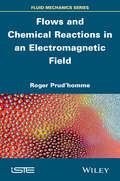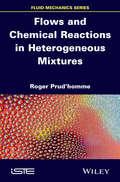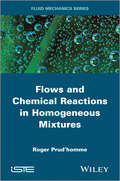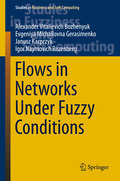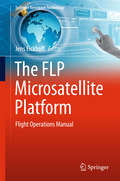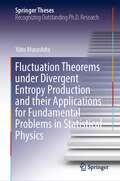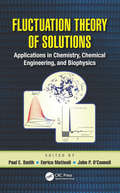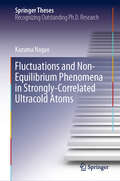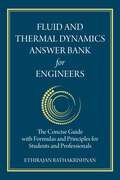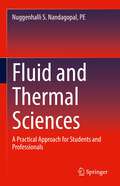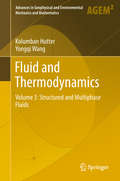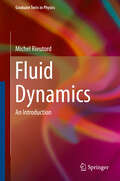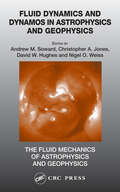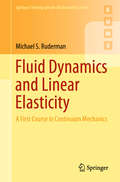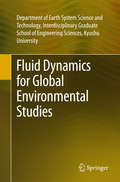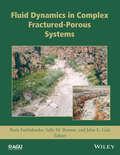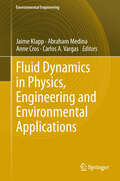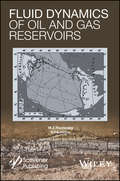- Table View
- List View
Flows and Chemical Reactions in an Electromagnetic Field
by Roger Prud'HommeThis book - a sequel of previous publications 'Flows and Chemical Reactions', 'Chemical Reactions Flows in Homogeneous Mixtures' and 'Chemical Reactions and Flows in Heterogeneous Mixtures' - is devoted to flows with chemical reactions in the electromagnetic field.The first part, entitled basic equations, consists of four chapters. The first chapter provides an overview of the equations of electromagnetism in Minkowski spacetime. This presentation is extended to balance equations, first in homogeneous media unpolarized in the second chapter and homogeneous fluid medium polarized in the third chapter. Chapter four is devoted to heterogeneous media in the presence of electromagnetic field. Balance equations at interfaces therein.The second part of this volume is entitled applications. It also includes four chapters. Chapter five provides a study of the action of fields on fire. Chapter six deals with a typical application for the Peltier effect, chapter seven is devoted to metal-plasma interaction, especially in the Langmuir probe and finally Chapter Eight deals with the propulsion Hall effect.Are given in appendix supplements the laws of balance with electromagnetic field and described the methodology for establishing one-dimensional equations for flow comprising active walls as is the case in some Hall effect thrusters.
Flows and Chemical Reactions in Heterogeneous Mixtures
by Roger Prud'HommeThis book - a sequel of previous publications 'Flows and Chemical Reactions' and 'Chemical Reactions in Flows and Homogeneous Mixtures' - is devoted to flows with chemical reactions in heterogeneous environments. Heterogeneous media in this volume include interfaces and lines. They may be the site of radiation. Each type of flow is the subject of a chapter in this volume.We consider first, in Chapter 1, the question of the generation of environments biphasic individuals: dusty gas, mist, bubble flow. Chapter 2 is devoted to the study at the mesoscopic scale: particle-fluid exchange of momentum and heat with determination of the respective exchange coefficients. In Chapter 3, we establish simplified equations of macroscopic balance for mass, for the momentum and energy, in the case of particles of one size (monodisperse suspension). Radiative phenomena are presented in Chapter 5.
Flows and Chemical Reactions in Homogeneous Mixtures
by Roger Prud'hommeFlows with chemical reactions can occur in various fields such as combustion, process engineering, aeronautics, the atmospheric environment and aquatics.The examples of application chosen in this book mainly concern homogeneous reactive mixtures that can occur in propellers within the fields of process engineering and combustion:– propagation of sound and monodimensional flows in nozzles, which may include disequilibria of the internal modes of the energy of molecules;– ideal chemical reactors, stabilization of their steady operation points in the homogeneous case of a perfect mixture and classical instruments of experimental and theoretical analysis such as population balances, and the distribution of residence and passage times;– laminar and turbulent flames, separating those which are premixed from those which are not and which do not exhibit the same mechanisms, but which also occur in the case of triple flames.Flows and Chemical Reactions in Homogeneous Mixtures provides information on dimensional analysis, statistical thermodynamics with coupling between internal modes and chemical reactions, the apparition and damping of fluid turbulence as well as its statistical processing, bifurcations, flames in a confined medium and diffusion. Contents 1. Flows in Nozzles.2. Chemical Reactors.3. Laminar and Turbulent Flames.Appendix 1. Dimensionless Numbers, Similarity.Appendix 2. Thermodynamic Functions.Appendix 3. Concepts of Turbulence.Appendix 4. Thermodynamic functions for a mixture in disequilibrium.Appendix 5. Notion of bifurcation.Appendix 6. Confined flame.Appendix 7. Limits of Validity of the First-order Expansions for Diffusion Flames.
Flows in Networks Under Fuzzy Conditions
by Alexander Vitalievich Bozhenyuk Evgeniya Michailovna Gerasimenko Janusz Kacprzyk Igor Naymovich RozenbergThis book offers a comprehensive introduction to fuzzy methods for solving flow tasks in both transportation and networks. It analyzes the problems of minimum cost and maximum flow finding with fuzzy nonzero lower flow bounds, and describes solutions to minimum cost flow finding in a network with fuzzy arc capacities and transmission costs. After a concise introduction to flow theory and tasks, the book analyzes two important problems. The first is related to determining the maximum volume for cargo transportation in the presence of uncertain network parameters, such as environmental changes, measurement errors and repair work on the roads. These parameters are represented here as fuzzy triangular, trapezoidal numbers and intervals. The second problem concerns static and dynamic flow finding in networks under fuzzy conditions, and an effective method that takes into account the network's transit parameters is presented here. All in all, the book provides readers with a practical reference guide to state-of-the art fuzzy methods for solving flow tasks and offers a valuable resource for all researchers and postgraduate students in the fields of network theory, fuzzy models and decision-making.
The FLP Microsatellite Platform
by Jens EickhoffThis book represents the Flight Operations Manual for a reusable microsatellite platform - the "Future Low-cost Platform" (FLP), developed at the University of Stuttgart, Germany. It provides a basic insight on the onboard software functions, the core data handling system and on the power, communications, attitude control and thermal subsystem of the platform. Onboard failure detection, isolation and recovery functions are treated in detail. The platform is suited for satellites in the 50-150 kg class and is baseline of the microsatellite "Flying Laptop" from the University. The book covers the essential information for ground operators to controls an FLP-based satellite applying international command and control standards (CCSDS and ECSS PUS). Furthermore it provides an overview on the Flight Control Center in Stuttgart and on the link to the German Space Agency DLR Ground Station which is used for early mission phases. Flight procedure and mission planning chapters complement the book.
Fluctuation Theorems under Divergent Entropy Production and their Applications for Fundamental Problems in Statistical Physics (Springer Theses)
by Yûto MurashitaThis book presents the derivation of the fluctuation theorems with divergent entropy production and their application to fundamental problems in statistical physics. It explores the two basic aspects of the fluctuation theorems: i) Applicability in extreme situations with divergent entropy production, concluding that the fluctuation theorems remain valid under the notion of absolute irreversibility, and ii) utility in the investigation of classical enigmas in the framework of statistical physics, i.e., Gibbs and Loschmidt paradoxes. The book offers readers an overview of the research in fundamental statistical physics. Firstly it briefly but skillfully reviews the modern development of fluctuation theorems to found the key theme of the book. Secondly it concisely discusses historical issues of statistical physics in chronological order, along with the key literature in the field. They help readers easily follow the key developments in the fundamental research of statistical physics.
Fluctuation Theory of Solutions: Applications in Chemistry, Chemical Engineering, and Biophysics
by Paul E. Smith Enrico Matteoli John P. O’ConnellThere are essentially two theories of solutions that can be considered exact: the McMillan-Mayer theory and Fluctuation Solution Theory (FST). The first is mostly limited to solutes at low concentrations, while FST has no such issue. It is an exact theory that can be applied to any stable solution regardless of the number of components and their co
Fluctuations and Non-Equilibrium Phenomena in Strongly-Correlated Ultracold Atoms (Springer Theses)
by Kazuma NagaoThis book discusses non-equilibrium quantum many-body dynamics, recently explored in an analog quantum simulator of strongly correlated ultracold atoms. The first part presents a field-theoretical analysis of the experimental observability of the Higgs amplitude mode that emerges as a relativistic collective excitation near a quantum phase transition of superfluid Bose gases in an optical lattice potential. The author presents the dynamical susceptibilities to external driving of the microscopic parameters, taking into account a leading-order perturbative correction from quantum and thermal fluctuations and shows clear signatures of the Higgs mode in these observables. This is the first result that strongly supports the stability of the Higgs mode in three-dimensional optical lattices even in the presence of a spatially inhomogeneous confinement potential and paves the way for desktop observations of the Higgs mode. In the second part, the author applies the semi-classical truncated-Wigner approximation (TWA) to far-from-equilibrium quantum dynamics. Specifically, he considers the recent experiments on quantum-quench dynamics in a Bose-Hubbard quantum simulator. A direct comparison shows remarkable agreement between the numerical results from TWA and the experimental data. This result clearly indicates the potential of such a semi-classical approach in reliably simulating many-body systems using classical computers. The book also includes several chapters providing comprehensive reviews of the recent studies on cold-atomic quantum simulation and various theoretical methods, including the Schwinger-boson approach in strongly correlated systems and the phase-space semi-classical method for far-from-equilibrium quantum dynamics. These chapters are highly recommended to students and young researchers who are interested in semi-classical approaches in non-equilibrium quantum dynamics.
Fluid and Thermal Dynamics Answer Bank for Engineers: The Concise Guide with Formulas and Principles for Students and Professionals
by Ethirajan RathakrishnanThis book provides the essence of aerodynamics, fluid mechanics, experimental methods, gas dynamics, high enthalpy gas dynamics, helicopter aerodynamics, heat transfer, and thermodynamics, describing the underlying principles of these subjects before list
Fluid and Thermal Sciences: A Practical Approach for Students and Professionals
by Nuggenhalli S. Nandagopal, PEThis text provides a clear understanding of the fundamental principles of thermal and fluid sciences in a concise manner in a rigorous yet easy to follow language and presentation. Elucidation of the principles is further reinforced by examples and practice problems with detailed solutions. Firmly grounded in the fundamentals, the book maximizes readers’ capacity to take on new problems and challenges in the field of fluid and thermal sciences with confidence and conviction. Standing also as a ready reference and review of the essential theories and their applications in fluid and thermal sciences, the book is applicable for undergraduate mechanical and chemical engineering students, students in engineering technology programs, as well as practicing engineers preparing for the engineering license exams (FE and PE) in USA and abroad.Explains the concepts and theory with a practical approach that readers can easily absorb;Provides the just the right amount of theoretical and mathematical background needed, making it less intimidating for the reader;Covers fluid and thermal sciences in a straight-forward yet comprehensive manner facilitating a good understanding of the subject matter;Includes a wide spectrum and variety of problems along with numerous illustrative solved examples and many practice problems with solutions.
Fluid and Thermodynamics
by Kolumban Hutter Yongqi WangThis first volume discusses fluid mechanical concepts and their applications to ideal and viscous processes. It describes the fundamental hydrostatics and hydrodynamics, and includes an almanac of flow problems for ideal fluids. The book presents numerous exact solutions of flows in simple configurations, each of which is constructed and graphically supported. It addresses ideal, potential, Newtonian and non-Newtonian fluids. Simple, yet precise solutions to special flows are also constructed, namely Blasius boundary layer flows, matched asymptotics of the Navier-Stokes equations, global laws of steady and unsteady boundary layer flows and laminar and turbulent pipe flows. Moreover, the well-established logarithmic velocity profile is criticised.
Fluid and Thermodynamics
by Kolumban Hutter Yongqi WangIn this book fluid mechanics and thermodynamics (F&T) are approached as interwoven, not disjoint fields. The book starts by analyzing the creeping motion around spheres at rest: Stokes flows, the Oseen correction and the Lagerstrom-Kaplun expansion theories are presented, as is the homotopy analysis. 3D creeping flows and rapid granular avalanches are treated in the context of the shallow flow approximation, and it is demonstrated that uniqueness and stability deliver a natural transition to turbulence modeling at the zero, first order closure level. The difference-quotient turbulence model (DQTM) closure scheme reveals the importance of the turbulent closure schemes' non-locality effects. Thermodynamics is presented in the form of the first and second laws, and irreversibility is expressed in terms of an entropy balance. Explicit expressions for constitutive postulates are in conformity with the dissipation inequality. Gas dynamics offer a first application of combined F&T. The book is rounded out by a chapter on dimensional analysis, similitude, and physical experiments.
Fluid and Thermodynamics: Volume 2: Advanced Fluid Mechanics And Thermodynamic Fundamentals (Advances In Geophysical And Environmental Mechanics And Mathematics Ser.)
by Yongqi Wang Kolumban HutterThis third volume describes continuous bodies treated as classical (Boltzmann) and spin (Cosserat) continua or fluid mixtures of such bodies. It discusses systems such as Boltzmann continua (with trivial angular momentum) and Cosserat continua (with nontrivial spin balance) and formulates the balance law and deformation measures for these including multiphase complexities. Thermodynamics is treated in the spirit of Müller–Liu: it is applied to Boltzmann-type fluids in three dimensions that interact with neighboring fluids on two-dimensional contact surfaces and/or one-dimensional contact lines. For all these situations it formulates the balance laws for mass, momenta, energy, and entropy. Further, it introduces constitutive modeling for 3-, 2-, 3-d body parts for general processes and materially objective variable sets and their reduction to equilibrium and non-equilibrium forms. Typical (reduced) fluid spin continua are liquid crystals. Prominent nematic examples of these include the Ericksen–Leslie–Parodi (ELP) formulation, in which material particles are equipped with material unit vectors (directors). Nematic liquid crystals with tensorial order parameters of rank 1 to n model substructure behavior better, and for both classes of these, the book analyzes the thermodynamic conditions of consistency. Granular solid–fluid mixtures are generally modeled by complementing the Boltzmann laws with a balance of fluctuation (kinetic) energy of the particles. The book closes by presenting a full Reynolds averaging procedure that accounts for higher correlation terms e.g. a k-epsilon formulation in classical turbulence. However, because the volume fraction is an additional variable, the theory also incorporates ‘k-epsilon equations’ for the volume fraction.
Fluid Dynamics
by Peter S. BernardThis book presents a focused, readable account of the principal physical and mathematical ideas at the heart of fluid dynamics. Graduate students in engineering, applied math, and physics who are taking their first graduate course in fluids will find this book invaluable in providing the background in physics and mathematics necessary to pursue advanced study. The book includes a detailed derivation of the Navier-Stokes and energy equations, followed by many examples of their use in studying the dynamics of fluid flows. Modern tensor analysis is used to simplify the mathematical derivations, thus allowing a clearer view of the physics. Peter Bernard also covers the motivation behind many fundamental concepts such as Bernoulli's equation and the stream function. Many exercises are designed with a view toward using MATLAB or its equivalent to simplify and extend the analysis of fluid motion including developing flow simulations based on techniques described in the book.
Fluid Dynamics
by Michel RieutordThis book is dedicated to readers who want to learn fluid dynamics from the beginning. It assumes a basic level of mathematics knowledge that would correspond to that of most second-year undergraduate physics students and examines fluid dynamics from a physicist's perspective. As such, the examples used primarily come from our environment on Earth and, where possible, from astrophysics. The text is arranged in a progressive and educational format, aimed at leading readers from the simplest basics to more complex matters like turbulence and magnetohydrodynamics. Exercises at the end of each chapter help readers to test their understanding of the subject (solutions are provided at the end of the book), and a special chapter is devoted to introducing selected aspects of mathematics that beginners may not be familiar with, so as to make the book self-contained.
Fluid Dynamics: An Introduction (Graduate Texts in Physics)
by Michel RieutordThis book is dedicated to readers who want to learn fluid dynamics from the beginning. It assumes a basic level of mathematics knowledge that would correspond to that of most second-year undergraduate physics students and examines fluid dynamics from a physicist’s perspective. As such, the examples used primarily come from our environment on Earth and, where possible, from astrophysics. The text is arranged in a progressive and educational format, aimed at leading readers from the simplest basics to more complex matters like turbulence and magnetohydrodynamics. Exercises at the end of each chapter help readers to test their understanding of the subject (solutions are provided at the end of the book), and a special chapter is devoted to introducing selected aspects of mathematics that beginners may not be familiar with, so as to make the book self-contained.
Fluid Dynamics and Dynamos in Astrophysics and Geophysics (The Fluid Mechanics of Astrophysics and Geophysics)
by Andrew M. Soward Christopher A. Jones David W. Hughes Nigel O. WeissThe increasing power of computer resources along with great improvements in observational data in recent years have led to some remarkable and rapid advances in astrophysical fluid dynamics. The subject spans three distinct but overlapping communities whose interests focus on (1) accretion discs and high-energy astrophysics; (2) solar, stellar, and
Fluid Dynamics and Linear Elasticity: A First Course in Continuum Mechanics (Springer Undergraduate Mathematics Series)
by Michael S. RudermanThis book provides a concise introduction to continuum mechanics, with a particular emphasis on fluid dynamics, suitable for upper undergraduate students in applied mathematics and related subjects.Starting with a preliminary chapter on tensors, the main topic of the book begins in earnest with the chapters on continuum kinematics and dynamics. Following chapters cover linear elasticity and both incompressible and compressible fluids. Special topics of note include nonlinear acoustics and the theory of motion of viscous thermal conducting compressible fluids.Based on an undergraduate course taught for over a decade, this textbook assumes only familiarity with multivariate calculus and linear algebra. It includes many exercises with solutions and can serve as textbook for lecture courses at the undergraduate and masters level.
Fluid Dynamics for Global Environmental Studies
by Kyushu Univ. Interdis.Grad Sch Engg Sci Dept. Earth Sys Sci. Tech.This book introduces the basic concepts of environmental fluid dynamics. It is intended for use by students, researchers, engineers, and specialists working not only in general fluid research but also in the atmospheric and oceanic research fields. The Earth is covered by atmosphere and oceans and is exposed to solar wind. Therefore, the knowledge of fluid dynamics is essential for tackling its environmental issues. Although many textbooks have treated fluid dynamics, practically no book has been published that clearly describes all essential ideas, from the fundamentals of fluid dynamics to advanced environmental sciences, with careful sequential explanations of the governing mathematics. This book has been developed to solve these educational problems and has actually been in use in lectures in the graduate school of Kyushu University for more than 15 years.
Fluid Dynamics in Complex Fractured-Porous Systems
by Boris Faybishenko Sally M. Benson John E. GaleDespite of many years of studies, predicting fluid flow, heat, and chemical transport in fractured-porous media remains a challenge for scientists and engineers worldwide. This monograph is the third in a series on the dynamics of fluids and transport in fractured rock published by the American Geophysical Union (Geophysical Monograph Series, Vol. 162, 2005; and Geophysical Monograph, No. 122, 2000). This monograph is dedicated to the late Dr. Paul Witherspoon for his seminal influence on the development of ideas and methodologies and the birth of contemporary fractured rock hydrogeology, including such fundamental and applied problems as environmental remediation; exploitation of oil, gas, and geothermal resources; disposal of spent nuclear fuel; and geotechnical engineering. This monograph addresses fundamental and applied scientific questions and is intended to assist scientists and practitioners bridge gaps in the current scientific knowledge in the areas of theoretical fluids dynamics, field measurements, and experiments for different practical applications. Readers of this book will include researchers, engineers, and professionals within academia, Federal agencies, and industry, as well as graduate/undergraduate students involved in theoretical, experimental, and numerical modeling studies of fluid dynamics and reactive chemical transport in the unsaturated and saturated zones, including studies pertaining to petroleum and geothermal reservoirs, environmental management and remediation, mining, gas storage, and radioactive waste isolation in underground repositories. Volume highlights include discussions of the following: Fundamentals of using a complex systems approach to describe flow and transport in fractured-porous media. Methods of Field Measurements and Experiments Collective behavior and emergent properties of complex fractured rock systems Connection to the surrounding environment Multi-disciplinary research for different applications
Fluid Dynamics in Physics, Engineering and Environmental Applications
by Abraham Medina Anne Cros Carlos A. Vargas Jaime KlappThe book contains invited lectures and selected contributions presented at the Enzo Levi and XVII Annual Meeting of the Fluid Dynamic Division of the Mexican Physical Society in 2011. It is aimed to fourth year undergraduate and graduate students, and scientists in the field of physics, engineering and chemistry that have interest in Fluid Dynamics from the experimental and theoretical point of view. The invited lectures are introductory and avoid the use of complicate mathematics. The other selected contributions are also adequate to fourth year undergraduate and graduate students. The Fluid Dynamics applications include multiphase flow, convection, diffusion, heat transfer, rheology, granular material, viscous flow, porous media flow, geophysics and astrophysics. The material contained in the book includes recent advances in experimental and theoretical fluid dynamics and is adequate for both teaching and research.
Fluid Dynamics of Oil and Gas Reservoirs
by M. Z. Rachinsky V. Y. KerimovWhether as a textbook for the petroleum engineering student or areference for the veteran engineer working in the field, this newvolume is a valuable asset in the engineer's library for new,tested methods of more efficient oil and gas exploration andproduction and better estimating methods. In this book, theauthors combine a rigorous, yet easy to understand, approach topetrophysics and how it is applied to petroleum and environmentalengineering to solve multiple problems that the engineer orgeologist faces every day. Useful in the prediction ofeverything from crude oil composition, pore size distribution inreservoir rocks, groundwater contamination, and other types offorecasting, this approach provides engineers and students alikewith a convenient guide to many real-world applications. Fluid dynamics is an extremely important part of the extractionprocess, and petroleum geologists and engineers must have a workingknowledge of fluid dynamics of oil and gas reservoirs in order tofind them and devise the best plan for extraction, before drillingcan begin. This book offers the engineer and geologist afundamental guide for accomplishing these goals, providingmuch-needed calculations and formulas on fluid flow, rockproperties, and many other topics that are encountered everyday. The approach taken in Fluid Dynamics of Oil and GasReservoirs is unique and has not been addressed until now in abook format. Readers now have the ability to review some of themost well-known fields in the world, from the USA to Russiaand Asia. Useful for the veteran engineer or scientist and the studentalike, this book is a must-have for any geologist, engineer, orstudent working in the field of upstream petroleum engineering.
Fluid Dynamics of Packed Columns
by Claudia Hall Jerzy MackowiakThis book provides support to engineers as well as graduate students in their daily design work within the industry or for the development of new plants. It investigates the key issues relating to the fluid dynamic design of packed columns used in rectification, absorption and stripping (desorption) under vacuum, normal pressure and up to 100 bar and liquid-liquid-extraction, which are relevant in waste air and wastewater technology. The author presents a standardised model, which is valid for any type of packing and can be used to calculate the gas velocity at flooding point as well as the liquid hold-up and the pressure drop throughout the entire operating range for random packings, stacked packings elements, tube columns and structured packings with different flow channel angles. The book also contains packing parameter data for approx. 200 random and structured packings. In addition to outlining the fundamental principles of fluid dynamics, it presents numerous examples of practical application.
Fluid Dynamics via Examples and Solutions
by Sergey NazarenkoFluid Dynamics via Examples and Solutions provides a substantial set of example problems and detailed model solutions covering various phenomena and effects in fluids. The book is ideal as a supplement or exam review for undergraduate and graduate courses in fluid dynamics, continuum mechanics, turbulence, ocean and atmospheric sciences, and relate
The Fluid Earth: Physical Science and Technology of the Marine Environment (3rd edition)
by E. Barbara Klemm Francis M. Pottenger III Thomas W. Speitel S. Arthur Reed Ann E. CoopersmithThis book offers students the opportunity to learn the basic concepts of science by investigating the oceans. They explore the physics, chemistry, and geology of the oceans and learn of their practical applications in ocean engineering.
